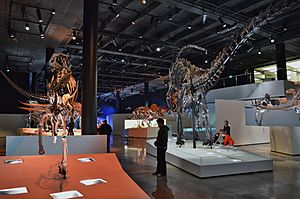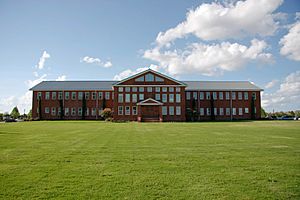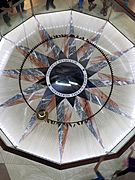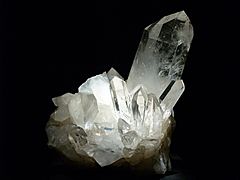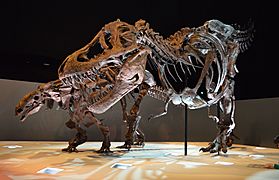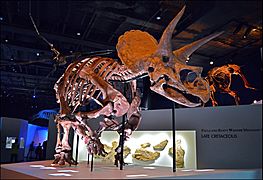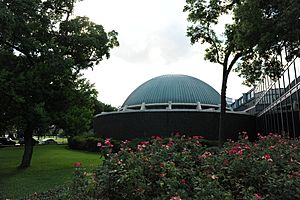Houston Museum of Natural Science facts for kids

Southeast entrance to HMNS
|
|
| Established | 1909 |
|---|---|
| Location | Houston, Texas |
| Type | Natural history museum |
| Public transit access |
Red Line
Museum District |
The Houston Museum of Natural Science (called HMNS) is a cool place to explore natural history. It is located in Houston, Texas, right next to Hermann Park. The museum started in 1909. Its main goal was to teach people in Houston about science for free.
Today, HMNS has a big main building with four floors of exhibits. It also has the Burke Baker Planetarium, the Cockrell Butterfly Center, and the Wortham Giant Screen Theatre. In 2022, over 1.5 million people visited the museum. This made it one of the most popular museums in the United States. Many people love HMNS because it often has exciting special exhibits.
Contents
Discovering the Museum's History
The museum began in 1909 as the Houston Museum and Scientific Society. Its first collections were gathered between 1914 and 1930. These included a nature collection from Henry Philemon Attwater. A gift from John Milsaps started the museum's amazing gem and mineral collection.
The museum's collections moved a few times. They were first in the city auditorium, then the Central Library. In 1929, they moved to the Houston Zoo. In 1947, the museum started its wide-ranging education programs. By its second year, 12,000 children had joined these programs.
In 1960, the museum officially became the Houston Museum of Natural Science. Construction for the current building in Hermann Park started in 1964. It was finished and opened in 1969.
New Exhibits and Growth in the 1980s
By the 1980s, the museum had many permanent displays. These included dinosaurs, space, geology, and biology. In 1988, the Challenger Learning Center opened. It was created to honor the brave crew of the Space Shuttle Challenger. This center teaches visitors all about space exploration. The Wortham IMAX Theatre and the George Observatory opened in 1989.
In 1990, more than one million people visited the museum. Because of this, the museum decided it needed more space. It also wanted to update its exhibits. Between 1991 and 1994, many exhibit halls were made new. The Sterling Hall of Research was also expanded. The Cockrell Butterfly Center and the Brown Hall of Entomology opened in July 1994.
In March 2007, HMNS opened a smaller location. It was called the Woodlands X-ploration Station. This spot had a fun Dig Pit where kids could dig for a pretend Triceratops. It also had live exhibits, fossils, and minerals. The Woodlands location closed in September 2009.
HMNS celebrated its 100th birthday in 2009. They had many family programs, talks, and free events. Kids' classes were also part of the "Fun Hundred" celebration. In October 2009, HMNS opened a new museum in Telfair, Sugar Land. This building was once part of a prison.
In March 2012, the Wortham IMAX Theatre was updated. It changed from film to 3D digital. It was then renamed the Wortham Giant Screen Theatre.
Expanding the Dinosaur Hall
In June 2012, HMNS opened a huge new section. This new wing was for its paleontology hall. It made the museum more than twice as big. A paleoartist named Julius Csotonyi created fourteen murals. These murals were based on ideas from Robert Bakker, the museum's Curator of Paleontology.
The Morian Hall of Paleontology is very impressive. It has over 60 large skeleton displays. These include three Tyrannosaurus rex and three big Quetzalcoatlus.
Exploring Permanent Exhibits
The Houston Museum of Natural Science has many amazing exhibits. Here are some of the main ones you can see:
- Foucault pendulum: This shows how the Earth spins. The pendulum's cable is over 60 feet long.
- Cullen Hall of Gems & Minerals: This hall has over 750 sparkling mineral specimens. It also shows off many rare gemstones.
- Lester and Sue Smith Gem Vault: Here you can see some of the most beautiful cut gems used in jewelry.
- Farish Hall of Texas Wildlife: This exhibit shows animals and plants that live in Texas. A video wall displays the different natural areas of the state.
- Evelyn and Herbert Frensley Hall of African Wildlife: This display features taxidermied animals from Africa. It includes one of only two okapis shown in North America. The hall opened in 1969. It lets visitors explore the seven main natural areas of Africa. There are over 120 animal displays, including 42 types of birds.
- Strake Hall of Malacology: This hall has many different kinds of mollusks.
- Morian Hall of Paleontology: This is the largest paleontology hall in the United States. It has over 60 large skeleton displays. These include three Tyrannosaurus rex and a Diplodocus. It also has the most complete Triceratops skeleton ever found. You can also see one of the biggest collections of trilobites here.
- John P. McGovern Hall of the Americas: This hall shows more than 50 different cultures. It displays pre-Columbian archaeological artifacts.
- Welch Chemistry Hall: This hall has fun, interactive chemistry displays. It also has a periodic table of elements with a sample of each element.
- Wiess Energy Hall: This hall teaches about energy, petroleum geology, and oil exploration. It was updated and expanded in 2017. It has 16 sections, including a working model of an offshore drilling rig. You can also take a pretend trip into the rock beneath Houston.
- Hall of Ancient Egypt: This hall opened in May 2013. It has many ancient artifacts. It also shows recreations of Egyptian temples and mummies.
- Cockrell Sundial: This sundial opened in 1989 and is one of the world's largest. It uses special lenses to cast an image of the Sun. You can even see sunspots!
- Earth Forum: This exhibit opened in 2002. It uses computers and hands-on displays to teach about Earth and its processes.
-
Foucault Pendulum on display
-
Quartz crystal from Hot Springs, Arkansas, on display
-
Triceratops skeleton at the Houston Museum in a controversial running posture
Museum Facilities to Explore
The Houston Museum of Natural Science has several special facilities:
Burke Baker Planetarium
The Burke Baker Planetarium shows many science and astronomy programs. As of 2016, it uses a special projection system called Digistar 5. It was one of the first 8k planetariums in the United States. The planetarium first opened in 1969. It has been updated many times to use the newest technology. Since 2004, its "Discovery Dome" program takes the planetarium experience to schools. It reaches over 40,000 students each year.
Cockrell Butterfly Center
The Cockrell Butterfly Center is a butterfly zoo inside the museum. It opened in 1994. The center is a three-story glass building filled with tropical plants. Many live butterflies fly freely inside. You can see migratory monarchs and other tropical butterflies. The center was updated in May 2007. It now has more interactive games for kids. There is also a live insect zoo in the Brown Hall of Entomology.
Wortham Giant Screen Theatre
The Wortham Giant Screen Theatre has 394 seats. It shows many educational films in 4K digital. It also uses advanced 3D technology. The screen is very large, measuring 60 by 80 feet.
George Observatory
The George Observatory is an astronomy observatory. It has three domed telescopes. These include a 36-inch Gueymard Research Telescope and a solar telescope. The observatory is located south of Sugar Land, Texas, at Brazos Bend State Park. It also has a part of the Challenger Learning Center.
See also
 In Spanish: Museo de Ciencias Naturales de Houston para niños
In Spanish: Museo de Ciencias Naturales de Houston para niños


